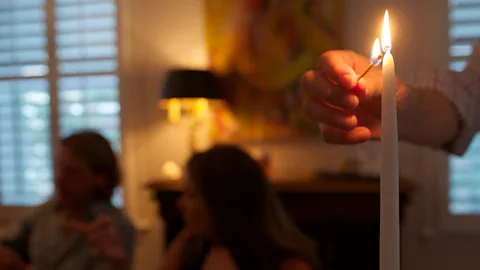What I learned by living without artificial light
 Getty Images
Getty ImagesLinda Geddes decided to live for weeks in only candlelight – no bulbs, no screens. Along the way, she discovered simple things that everyone can try to sleep and feel better.
This story is featured in BBC Future’s “Best of 2018” collection. Discover more of our picks.
We spend a third of our lives either sleeping… or trying to get to sleep. But in the world of 24/7 living and artificial light, our sleep is increasingly under threat.
Many of us don’t get the recommended seven to nine hours we need each night and struggle to get up in the mornings – especially on work days. But it isn’t only our quantity of sleep that’s affected. Since the discovery that light (particularly blue light, emanating from devices like smartphones) can affect our biological clocks, evidence has been building that exposure to even low levels of light in the evening or at the night is disrupting our sleep quality, as well.
So what would happen if we turned off the lights? Would it improve our sleep or have other benefits? And how easy would this be to achieve in a modern city?
You might also like:
• How much sleep do we really need?
One recent winter, I decided to find out. Working with sleep researchers Derk-Jan Dijk and Nayantara Santhi at the University of Surrey, I designed a programme to go cold-turkey on artificial light after dark, and to try to maximise exposure to natural light during the day – all while juggling an office job and busy family life in urban Bristol.
The discoveries I've made have revolutionised my attitude to light – and how I live my life during the night and day. I now make simple, daily choices that can transform how I sleep, how I feel and perhaps even my cognitive abilities. Could you be doing the same?
 Getty Images
Getty ImagesFor millennia, humans lived in synchrony with the natural cycle of light and dark. This doesn’t mean that everyone went to sleep as soon as the Sun set. Studies of pre-industrial societies, such as tribes living in Tanzania or Bolivia today, suggest that people stay up for several hours after dark, often socialising by firelight. In fact, the amount of sleep they get is quite like people in industrialised countries, but the timing is more in line with the natural cycle of day and night: they tend to go to bed earlier and get up just before dawn.
“In modern societies, at least on weekdays, we don’t sleep in tune with our body clock,” says Dijk. Exposure to artificial light at night is shifting our body clocks later. But we still need to go to work in the morning, so we set an alarm clock – even though the biological clock says we should still be asleep.
Pre-industrial societies such as the Hadza tribe in Tanzania also seem to have a far lower prevalence of sleep problems, like insomnia. “When we asked of the Hadza whether they thought their sleep was good, they almost universally said ‘yes, it’s totally fine’. That statistically doesn't match up with what we see in the West,” says David Samson, an anthropologist at the University of Toronto in Mississauga, who has studied them.
 Getty Images
Getty ImagesWhy is this? Light enables us to see, but it affects many other body systems as well. Light in the morning advances our internal clock, making us more lark-like, while light at night delays the clock, making us more owlish. Light also suppresses a hormone called melatonin, which signals to the rest of the body that it’s night-time – including the parts that regulate sleep. “Apart from vision, light has a powerful non-visual effect on our body and mind, something to when we stay indoors all day and have lights on late into the night,” says Santhi, who previously demonstrated that the evening light in our homes suppresses melatonin and delays the timing of our sleep.
However, light also boosts alertness in its own right. It’s like drinking a double espresso. Although these stimulant effects are bad news if you’re trying to sleep, being exposed to more bright light during the daytime could make us more alert. Light also stimulates brain regions that regulate mood.
“The important thing is that we create a light exposure pattern with sufficient light during the day, and not too much light in the evening,” says Dijk.
Despite this logic, persuading my family to let me switch to this way of living took some effort. When I suggested to my husband that living by candlelight might be romantic, he rolled his eyes. But convincing him was a doddle compared to my six-year-old daughter and four-year-old son. Here’s how that conversation went:
Me: Children, we’re going to try living in the dark for a few weeks
Daughter: But that will be spooky.
Me: No, I think it could be lots of fun. We’ll have candles.
Daughter: *bursts into tears*
Me: Please don’t cry. It will be like going camping.
Son: Can we have marshmallows?
Several packets of marshmallows later, we were set – although I agreed that my husband could occasionally use electric lighting and the kids could watch television, provided I wasn’t nearby. Because I needed to maintain a normal work schedule, I also decided to keep the lights on until 18:00, although I switched my laptop to ‘night mode’ after sunset.
 Getty Images
Getty ImagesThe protocol looked like this: during the first week, I would try to maximise my exposure to daylight by moving my desk next to the window, lingering in the park on the way back from school drop-off each morning, getting outside at lunchtime and trying to exercise outdoors. The second experimental week would be spent minimising my exposure to artificial light after 18:00, relying on candle-light or dim red lighting instead. Then I would combine the two.
In between each of these intervention weeks, I would lead a normal life. These weeks would function as a baseline.
To track my responses, I’d wear an ‘actiwatch’ to measure light exposure, activity and sleep. I'd also complete sleep diaries and questionnaires to assess my sleepiness and mood and undertake a battery of cognitive tests to assess my short-term memory, attention and reaction speeds. On the last evening of each week, I would spend the evening in darkness, taking hourly samples of my melatonin, which is released in response to a signal from the biological clock and therefore provides a marker of our internal time. “Melatonin is our hormone of darkness; it creates the biological night,” says Marijke Gordijn, a chronobiologist at the University of Groningen in the Netherlands, who measured my melatonin levels.
The idea was to see if these changes to my light exposure altered the timing of my biological clock. We were curious to see if any of the benefits predicted by larger, well-controlled laboratory studies would translate into real life.
“We’ve done a lot of experiments where we’ve given a dose of light and seen that it shifts the clock,” says Gordijn. “But if we want to apply those findings to help people, we need to know that it will have the same effect when the environment is more variable.”
Switched on
And so, on a bright and sunny December morning, I found myself in the local park, inconspicuously trying to work out on the monkey-bars and swings instead of going to a body pump session in the gym. "Mummy, what's that lady doing">window._taboola = window._taboola || []; _taboola.push({ mode: 'alternating-thumbnails-a', container: 'taboola-below-article', placement: 'Below Article', target_type: 'mix' });
